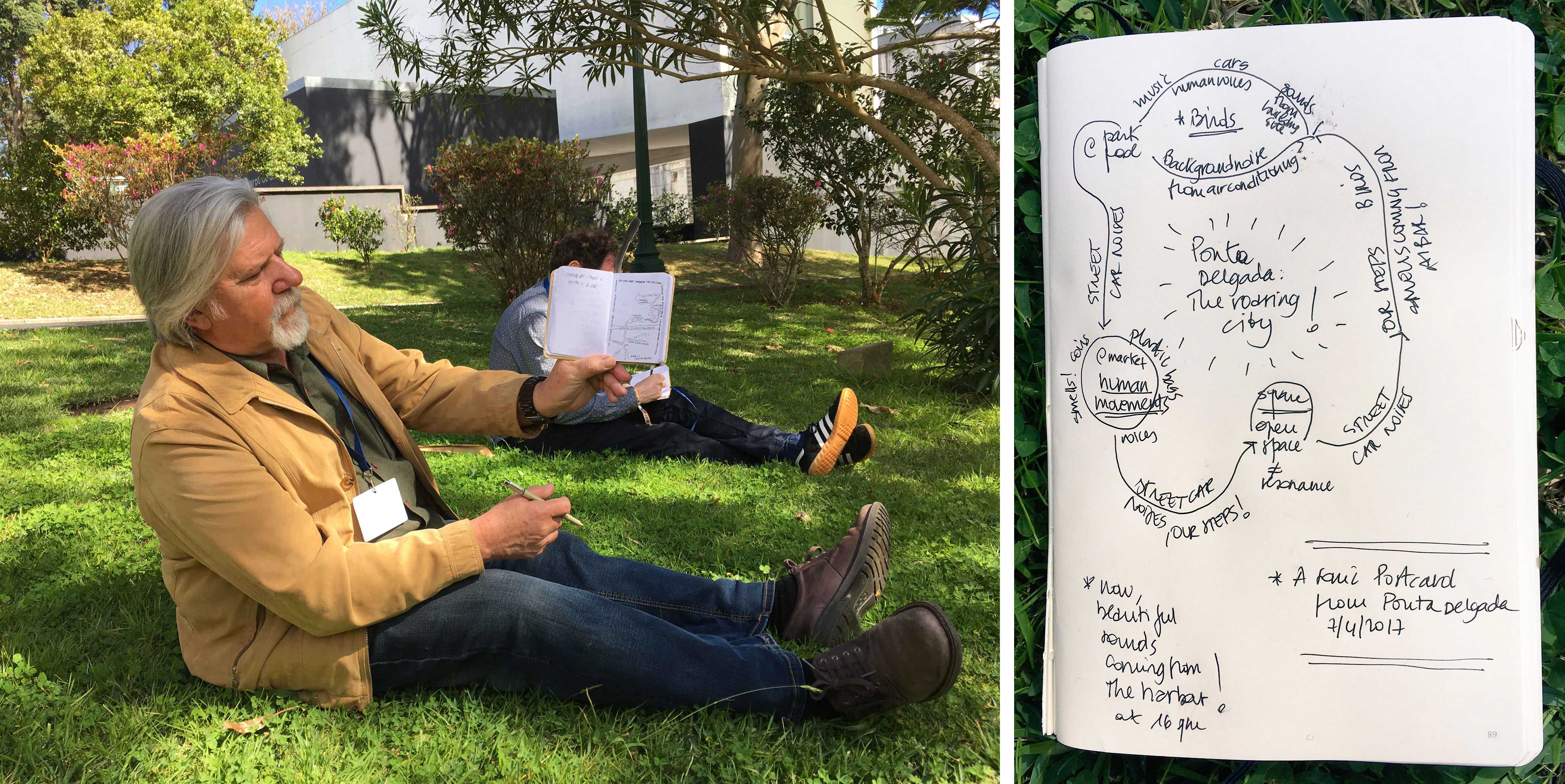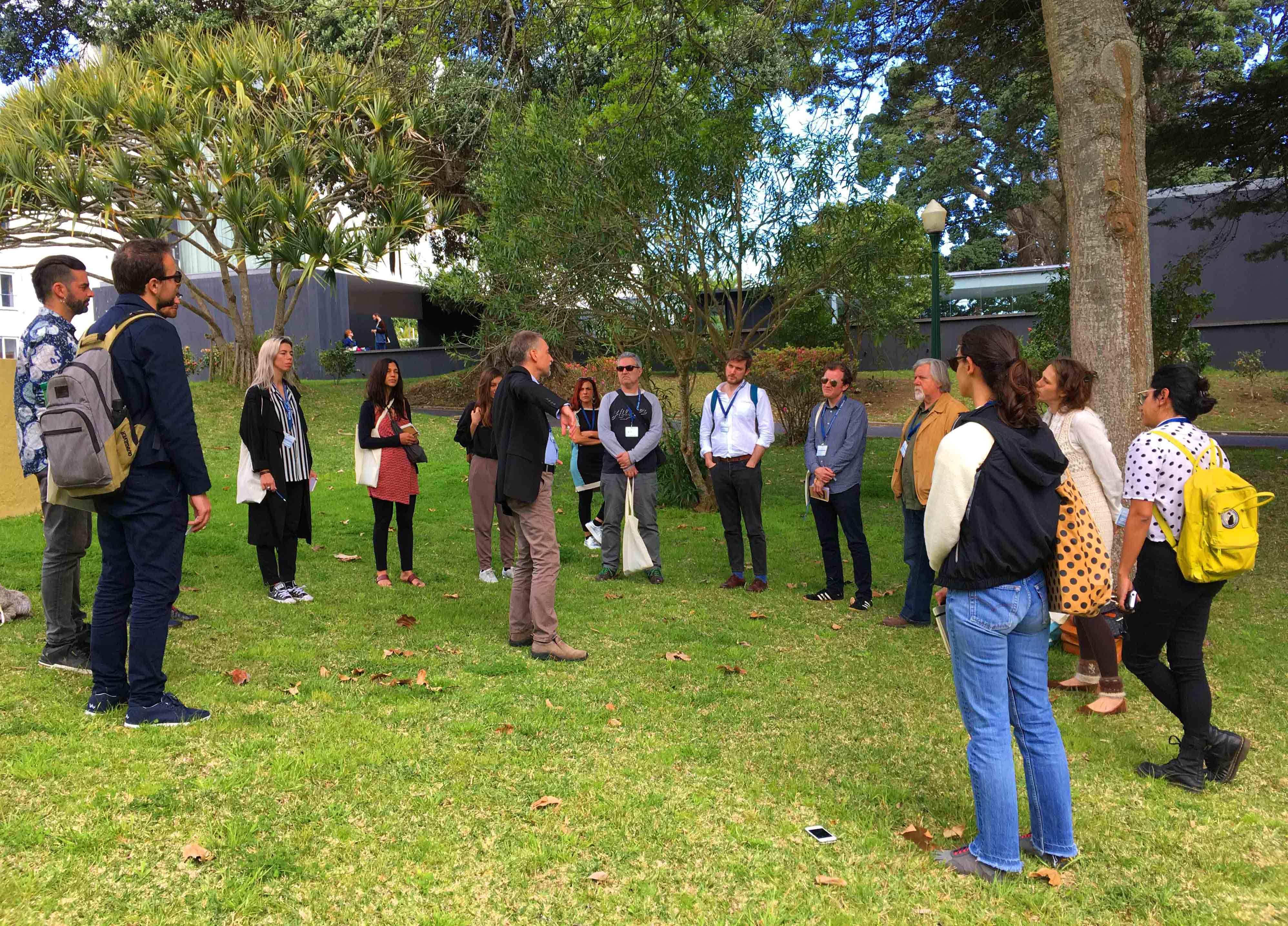This year I attended the Invisible Places Conference. And, yes, it was great!
Invisible Places. Sound, Urbanism and Sense of Place is a triennial* conference, which was kicked off in 2014 in Viseu, Portugal. The 2017 edition took place in the amazing venue of Ponta Delgada on April 7-9, at the University of the Azores in S. Miguel Island. It was organized by the brilliant Rachel Castro and Miguel Carvalhais, with the aim of bringing “together scholars, artists and theoreticians on soundscape art and ecology and encourage them to present new perspectives that will further interdisciplinary research and practice” on sound, urbanism, sense of place, and acoustic ecology.
The program – very intense! – was composed of parallel talk sessions, workshops, concerts, sound installations and social events, in addition to three excellent key-notes by Juhani Pallasmaa, Hildegard Westerkamp and Sam Auinger. Due to the conference organization based on parallel sessions, there was no chance to attend all the presentations and events, so I had to choose and pick up what it would have been closer to my interests and background.
During the first day, I attended the paper session no. 1, where Jordan Lacey and Stephan Moore presented the Transurban project made in Melbourne, Antti Ikonen discussed acoustic ecology in the digital era and Nicola di Croce dealt with the issue of sonic identity, illustrating the results of his sound art residency at San Cipriano Picentino (IT). I also participated in the workshop run by Eric Leonardson and Amanda Gutierrez on how soundwalks engage urban communities in soundscape awareness.
The workshop started with an introduction given by Eric and Amanda, who presented their approach to soundwalking and several soundwalk projects they have been involved in. Then we go out for the soundwalk: first, we made some exercises for ear cleaning and ear calibration then we soundwalked in the surroundings of the conference’s venue, exploring the beautiful and quiet park with the pool, the tiny and noisy streets, the lively market and the sonic effects given by the local architecture.
At the end of the soundwalk, we were encouraged to draw our sound mental maps of the soundwalk and to discuss our impressions with the group. This is my Sonic Postcard from Ponta Delgada along with the map designed by Reinhard Reitzenstein!

On the left, Reinhard Reitzenstein showing his sound mental map; on the right, my Sonic Postcard from Ponta Delgada.
It was a very rewarding and inspiring experience!
Day first ended with the key-note by Juhani Pallasmaa, titled Touching the world: through an historical excursus aimed to explain our vision-centred culture, he denounced that our “cities have lost their echo”, reclaiming for sensory architecture and urbanism in balance with our primary and most important sense: the existential one.
The day after, I attended the talk session no. 9, where scholars and artists like Thomas Kusitzky, Eric Somers and Barry Morse presented their research works: Kusitzky, in detail, gave a talk focusing on “cultivating urban sound as object of design”, attempting to build a new theory for “auditive architecture”.
In the afternoon, it was my turn!
I presented the Hush City app, a new mobile app, which I have developed to empower local communities to identify, map and evaluate quietness on their neighbourhoods. Trough the Hush City app, I also attempt to create a bridge between the traditional acoustic planning approach and the soundscape one, allowing for the collection of both quantitative and qualitative data.
So, if you want to join the community and help us in creating a worldwide map of quietness, click here to download the app!
Day two went on with the key-note given by Hildegard Westerkamp on “the practice of listening in unsettled times”. Hildegard Westerkamp is one of my heroes. And I was deeply touched by her talk, which was also very personal and moving. She encouraged us to practice a free and open listening, without barriers and prejudices, resisting to the impulse of providing advices and sharing experiences. She concluded her talk with a remarkable invitation to establishing connection with the acoustic engineers and hard scientists, in name of the inherent interdisciplinary nature of soundscape. After the key-note, a surprise concert by Peter Cusack took place in the beautiful frame of the Church of Mãe de Deus on the top of an hill, nearby the University, from where we could appreciate a fantastic panorama of the seaside. Delighted by the concert, we spent the evening together at the social dinner, where we kept on talking about soundscape research, sound art, architecture, future cities, smart mobility and so on. Time flew away!
The final day of the conference started with the key-note Quiet is the New Loud given by Sam Auinger, who presented the project made by O+A in the frame of the 2015 Brugge Triennale. I was intrigued by the Earmarks map, which was one of the outputs of the project: a map reporting the most interesting sonic places of the historical center of Brugge. In some way, it recalls to my mind the Berlin Sonic Places, a research project done by Peter Cusack in 2012 in Berlin. It’s always interesting observing how sound artists approach architecture and urbanism and being inspired by their alternative ideas and visions. A collective sound expedition to Arquipélago concluded the conference: pictures and videos from these incredible days are available here on the Facebook page of the conference.
What a rewarding experience!
I came back to Berlin full of energy and positive vibrations, and with many new ideas to test in the frame of my Beyond the Noise project.
Thanks to the Invisible Places’ crew and to people from S. Miguel who made my stay an unforgettable experience!

Views from S. Miguel. On the top, Sete Citades Lagoon; on the left, a sample of Figueira Australiana in the Botanical Garden of Ponta Delgada; on the right, the vulcanic coast of Ferreira.
—
* Raquel and Miguel say that they “still don’t know if this is a triennial conference, let’s see where the wind will take us!“.
